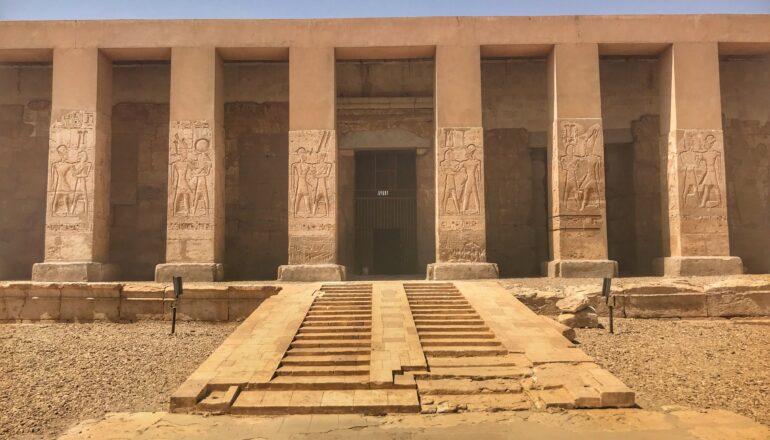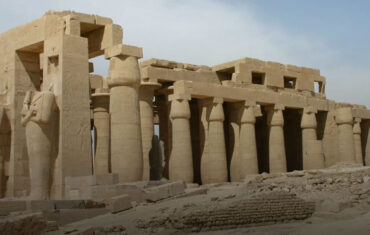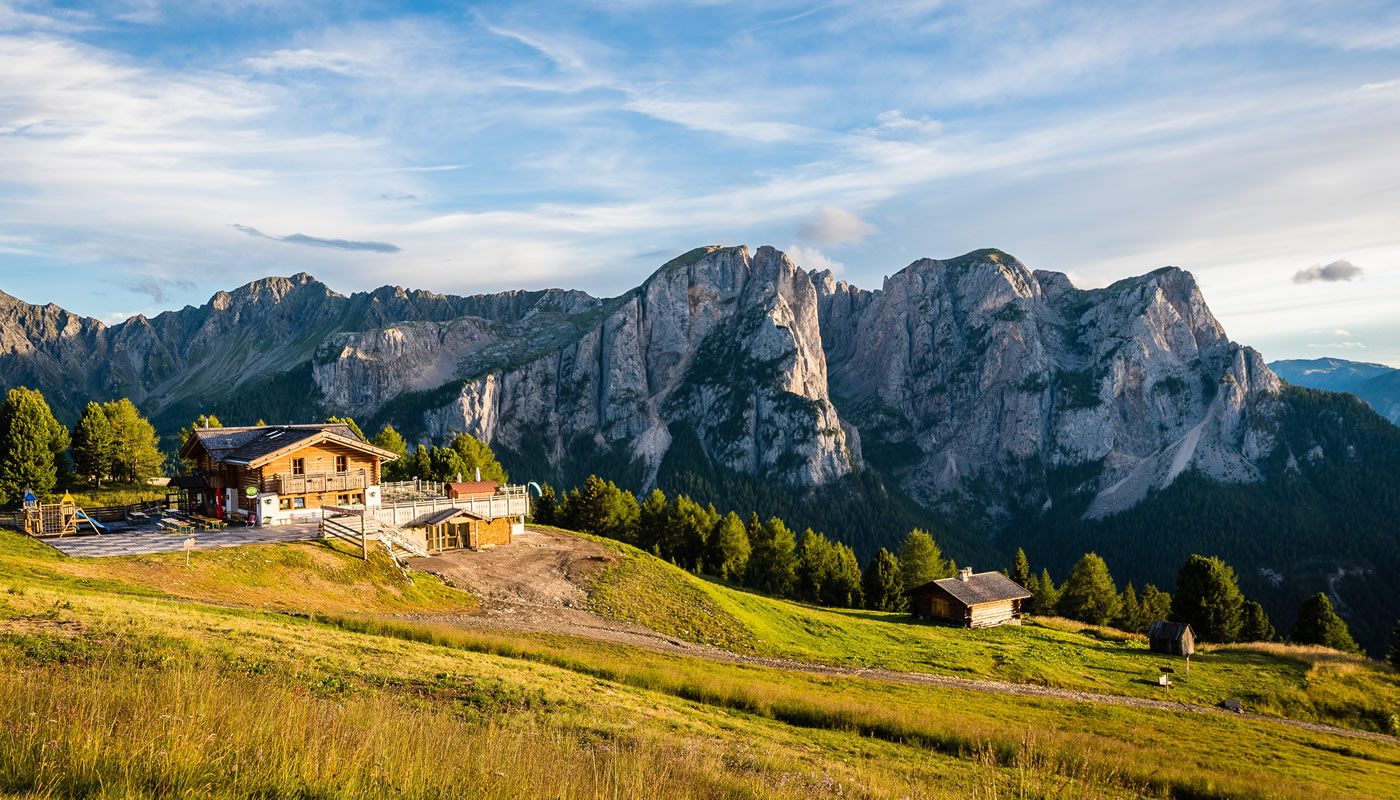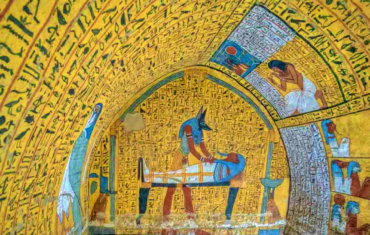The ancient Egyptian city of Abydos
Just as Muslims hope to visit Mecca at least once in their lives, and many Hindus would like to die in Benares, so the ancient Egyptians piously longed to make a pilgrimage to Abydos, the center of the cult of the God Osiris. Those who could not make it in life hoped to go there after death: people brought here the bodies of deceased relatives or decorated their tombs with scenes of the journey to Abydos (a picture of a boat under sail, sailing up the river).
The ancient Egyptians believed that the dead “go to the West”, and the entrance to the afterlife is somewhere among the desert hills near Abydos. As other deities entered the circle of Osiris, Abydos became an almost exclusive center of the funeral cult, which continued to play this role well into the Hellenistic period. The magnificent temple of SETI I has been attracting tourists since the 1930s, and many consider the works of art that adorn This complex to be the best in all of Egypt.
Ancient Egyptian temple architecture
Since ancient times, two types of temples have developed in Egypt: cult structures dedicated to the Supreme deities of a particular region, and memorial temples ” associated with the veneration of deceased kings. The temple of the first type was considered to be the “dwelling of the God” (pr-ntr), whose statue was daily “humored” with various rites and periodically taken to another temple to meet with the divine spouse.
Such cult complexes originally had a complex structure in contrast to memorial temples, which at the beginning of their history had the form of simple structures with two internal rooms attached to the pyramids of the pharaohs and connected to the valley temples by a covered passage. It was only during the New Kingdom those funeral temples began to be built separately from tombs and turned into huge architectural ensembles.
Most temple complexes in the Nile Valley were built over several centuries: some of the rulers built entire buildings, others limited themselves to decorating one wall or placing an inscription with their name on a statue of another Pharaoh. The General shape and layout of temples built from unyielding time-resistant stone, practically did not change for many millennia, continuing to serve as a model for the builders of the Hellenistic and Roman eras.
Temple of SETI I in Abydos
Unlike the Karnak temple and Deir El-Bahri, which amaze visitors with their colossal size, the Abydos temple of SETI I attracts primarily with its exceptional technique of execution reliefs. In these masterpieces of the New Kingdom era, a return to the artistic forms of the Ancient Kingdom is clearly visible – the revival in art reflected the political attempts of SETI I to strengthen the power of the XIX dynasty and regain the territories lost under Akhenaten.
The official name of the reign of SETI I (1318-1304 BC) sounds like “the age of repeated births” – the Renaissance, literally translated into modern language. SETI’s son Ramesses II (1304-1237 BC) completed the conquest of the once-ruled territories of Egypt and the construction of his father’s temple in Abydos. Strictly speaking, this structure has never been either a cult center or a memorial temple in the conventional sense of the word.
The sanctuary of the temple belonged to various deities associated with death, resurrection, and afterlife, and one of them – to the Network I. the plan of the temple was essentially political: to equate SETI I with these deities and his alleged “ancestors”, the previous pharaohs, and thereby to legitimize the power of the Ramesside dynasty, whose representatives for several generations before the events described were simple soldiers of the Nile Delta.
Over the centuries, the temple has not lost its charm. Modern pilgrims follow in the footsteps of Dorothy Eady, known as OMM SETI (“Mother of SETI”), who lived in Abydos for 35 years and until her death in 1981 believed that the ancient Egyptian priestess, SETI I’s mistress, had returned to the world in her body. Her own book Abydos – The Holy City in Ancient Egypt is available for purchase in Luxor, and her visions and prophetic gift are described in a biography written by Jonathan Cott – The Search for Omm Seti.
Temple court and hypostyle
The pylon and courtyard of the ancient temple are almost completely destroyed, but on their remains you can still distinguish the lower parts of reliefs with images of Ramesses II’s very dubious victory at Kadesh, women with elaborate braided hair and the Pharaoh SETI bringing gifts to Osiris (in a niche next to it). Following the damaged statues that now stand in the second, upper courtyard, visitors ‘ attention is drawn to the facade with rectangular columns, where tiny birds nest in the cracks of the wall behind pillars decorated with images of Ramesses before Osiris, ISIS and the Chorus. Originally, there were seven doors leading to the temple (according to the number of shrines inside), but by order of Ramesses, all the doorways, except the Central one, were blocked. The upper part of the facade was roughly constructed of concrete.
Judging by the massive carved reliefs in the outer hypostyle, completed after SETI’s death, Ramesses employed second-rate sculptors, transferring SETI’s best craftsmen to build his own (now demolished) temple. On the walls at the entrance, Ramesses is depicted measuring the temple area with the goddess Selket and dedicating the temple to Horus in the name of SETI. On the wall to the right, Ramesses presents a coffer of papyrus decorated with a Falcon’s head to ISIS, Horus, and Osiris, and follows Horus and Upuaut (the Jackal-headed deity of Assiut) to the temple to plunge into the sacred water (it is depicted as a combination of two hieroglyphs meaning “water” and “purity”). On one of the lintels is a cartouche, which has become one of the popular myths of the Internet: it depicts something similar to a helicopter and a submarine.
However, archaeologists see in the “Abydos helicopter” a typical case of applying a later cartouche on top of its predecessor, which, together with natural erosion, led to a distortion of the shape of the sign. By the way, the improved digital image on the network looks much clearer than the grim original. The second hypostyle, the inner one, was the last room of the temple, the decor of which was created during the lifetime of SETI. Some parts of the hypostyle have remained unfinished, but there are real masterpieces in it. On the wall to the right, SETI is depicted standing in front of Osiris and the Chorus, who pour Holy water from garlanded vessels, and offering sacrifices in the sanctuary of Osiris, with Maat and Ron-pet (the goddess of the year) standing in front, and ISIS, Amentet (the goddess of the West) and Nephthys following the Pharaoh.
Although the profile image of the Network looks rather conventional, it has a certain portrait resemblance to the Pharaoh’s mummy (stored in the Egyptian Museum of Cairo the Eastern and Western walls are made of Sandstone, while the Northern and southern walls are made of limestone. Two projecting half-columns at the back of the hypostyle depict SETI in the crown of Two Lands, standing in a prayer pose before the Djed pillar. On the reliefs of the back wall of the hypostyle, bright colors have been preserved. On the wall between the shrines of RA-Hor-Akhty Ptah and, at the height of human height, you can see the best of the reliefs of the second hypostyle hall: it depicts the Pharaoh kneeling before Osiris and Horus, against the background of the sacred Perseus tree.
The cult of Osiris
The cult of Osiris, the local fertility deity of the city of Busiris in the Delta, acquired General Egyptian significance in the era of the Ancient Kingdom, when this God was included in the Heliopolis eight. According to legend, RA (or GEB) divided power between two brothers, Osiris and set, but the latter did not want to rule only the deserts, and he killed his brother to usurp his Kingdom. ISIS, the sister and spouse of Osiris, found the body of her husband, but Seth again stole it and cut it into pieces, which he scattered in different places (according to one version, he fed the sexual organ of Osiris to a crocodile). Together with her sister Nephthys, ISIS gathered all the body parts and connected them with the help of veils, thus creating the first mummy.
With the help of Thoth and Anubis, Osiris was raised from the dead. Transformed into a female vulture, ISIS conceived a child by Osiris, before he returned to the world of the dead to rule it and judge the souls of dead men, their son Horus, who had been secretly raised in the Delta, subsequently avenged his father and banished Set back to the desert. In Abydos, which was considered the burial place of the body (or head) Two annual festivals were held in honor of Osiris. The rite of the “Great exit” ritually repeated the search for and finding of the remains of the God, and during another festival, mysteries were arranged, the basis of which was the story of the myth of Osiris.
So, in one of the acts, the servants of Set “attacked” the rook of the God, which was “protected” by Upuaut, the Jack-headed God of Siut (modern Assiut). This scene reflected the final stage in the process of merging various cults, as Upuaut took the place of Khenti-Amenti, the original deity of the Abydos necropolis, as “pre-Existent to the Westerners” before being integrated into the cult of Osiris. Abydos ‘strong associations with funeral cults were also reinforced by its Association with the veneration of the Jackal-headed Anubis, the embalmers’ deity who is always present in funeral scenes.
Southern wing of the temple of SETI
From the inner hypostyle you can go to the southern wing of the temple of SETI. The nearest portal to the king’s Shrine leads to the pillared hall of Sokar and Nefertum, two deities of Northern Egypt who represented the life force of the earth and the cycle of death and rebirth. By the time of the Net, their cults had merged into that of Osiris. Statues of Osiris once stood in niches along the wall to the left. The reliefs on the opposite wall depict SETI walking towards Sokar, who is depicted with the head of a Falcon, and Nefertum, who is represented in both his guises – a man and a lion (crowned with a Lotus flower).
In the Sokar chapel, Osiris is depicted on a funeral bier (at the far end of the right wall), and opposite we see ISIS hovering over his body in the form of a female vulture. To see inside the sanctuary of Nefertum, which is accessed by the next door, you will need a torch. The next portal opens to the Gallery of Kings, named for the list of Network’s predecessors carved on the right-hand wall. For political reasons, it did not include the names of the Hyksos rulers, Hatshepsut, Akhenaten and his heirs, and SETI I ordered his own name to be written as Men-Maat-Ra Osiris-Merneptah (and not Men-Maat-Ra SETI-Merneptah), so that it did not remind of his namesake Set, the murderer of Osiris.
Despite all this, the list is of great value to Egyptologists, as it lists the names of 34 kings (mainly from the VI, VII, XII, XVIII and XIX dynasties) in strict chronological order. The figures of SETI and his son Ramesses are shown facing an inscription containing the names of their “ancestors” beginning with Menes (Djoser). Since entry to the rook Sanctuary and the Hall of sacrifice is forbidden, it is best to proceed along a side corridor, past a live scene of SETI and Ramesses harnessing an ox and hurrying to meet Upuaut, and through a back door to Osirion, located behind the temple.
Osirion and the remains of other structures
The archaeological complex of Abydos occupies a huge territory at the edge of the desert, which is scattered with ruins of buildings and mounds. Few visitors have enough time for long walks, even if the police allow them to go far, but the building directly behind the temple of SETI deserves attention. When Flinders Petrie in the early twentieth century led excavations at Abydos, he found numerous Mastabas, which took over the Royal tombs.
Subsequently, Egyptologists began to consider them cenotaphs or symbolic burial sites of Osiris – false tombs built to ensure a close connection between the God and the “ka” of the deceased Pharaoh, whose mummy was located somewhere else. The Cenotaph of SETI, known as the Osirion, is the only one of these structures that can be seen today, although it is half buried in sand and partially inaccessible due to standing water. Inside the structure of massive stone blocks was once a mound surrounded by a moat (symbol of the first Holm rising from the waters of chaos at the dawn of the world), and a sarcophagus.
About 300 meters to the North is the dilapidated temple of Ramesses II, son of SETI. On the outer walls and in the inner courtyard of the temple surrounded by columns, you can still see fragments of reliefs with scenes of the battle of Kadesh. Archaeological sites located further away give us information about the history of the early Dynastic period. The German archaeological Institute has been excavating the early dynastic Royal necropolis at Umm al-Geaab since 1977, and a few years later it began investigating the burial sites at Shunet el-Zebib.
From the complex of Khaa-Sekhem-Ui, the last king of the II dynasty, who died around 2686 BC, walls up to 11 meters high and 5.5 meters thick have been preserved, surrounding a site with a length of 122 meters and a width of 65 meters. Dr. Gunther Dreyer believes that the ancestors of the pyramids at Saqqara were the fences of the Abydos tombs, which were located below ground level and lined with raw bricks. Hieroglyphic inscriptions have been found here, earlier than the monuments from Saqqara, which suggest that a pre-dynastic ruler named Horus conquered the Delta and unified It Egypt a century before Narmer.
In 1991, six solar rooks were found on the territory of the Kha-Sehem-Wi complex, which presumably date back to the reign of king Ah of the I dynasty (about 2920-2770 BC). All this suggests that the burial of the early dynastic rulers who, as is commonly believed to have been committed in Saqqara, in fact, could have taken place at Abydos, and that an intact Royal tomb would one day be found here.





